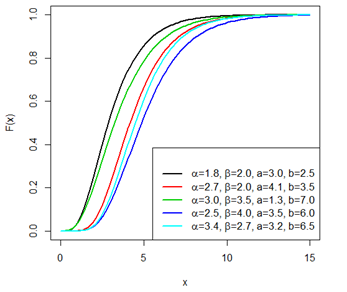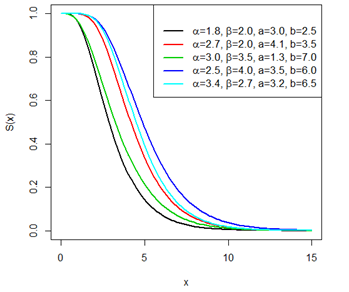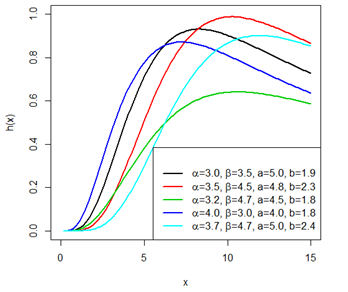A four parameter compound continuous distribution for modeling lifetime data known as the Odd Generalized Exponentiated Inverse Lomax distribution was proposed in this study. Basic Structural properties were derived in minute details.
Keywords: odd generalized Exponentiated family, inverse lomax distribution, moments, reliability function, hazard function, continuous distribution
Various distributions have been proposed to serve as models for wide applications on data from different real-life situations through the extension of existing distribution. This has been achieved in various ways. The Lomax distribution also called "Pareto type II" is a special case of the generalized beta distribution of the second kind,1 and can be seen in many application areas, such as actuarial science, economics, biological sciences, engineering, lifetime and reliability modeling and so on.2 This heavy duty distribution is considered useful as an alternative distribution to survival problems and life-testing in engineering and survival analysis.3 Inverse Lomax distribution is a member of the inverted family of distributions and discovered to be very flexible in analyzing situations with a realized non-monotonic failure rate.4 If a random variable has a Lomax distribution, then has an inverse Lomax Distribution. Thus, a random variable is said to have an Inverted Lomax distribution if the corresponding probability density function and cumulative density function are given by Yadav et al.5
(1)
(2)
In literature exist several family of distribution and the references to them are listed in Alizadeh et al.
6,7 In the course of this study, the Odd Generalized Exponential family of distribution developed by Alizadeh
8 having probability density and cumulative distribution function given by;
(3)
(4)
was used to extend the Inverse Lomax distribution. The goal is to derive a continuous compound distribution that would be robust and tractable than the Inverse Lomax distribution. The rest of the article is structured as follows: In section 2, we derive the cumulative distribution function, probability density function, reliability function, odd function, hazard function, reverse hazard function, and cumulative hazard function of the Odd Generalized Exponentiated Inverse Lomax distribution, and present their respective plots for different values of the parameter. In minute details, we establish the structural properties, which include the asymptotic behavior, moments, quantile function, median, Skewness and kurtosis, in section 3. In section 4, we determined the order statistics and the estimate of the unknown parameter using maximum likelihood estimation techniques. Application to two different lifetime dataset and a conclusion is made in section 5.
A four parameter Odd Generalized Exponentiated Inverse Lomax distribution was investigated in this section. Obtained by substituting equation (2) into (4), the cumulative distribution function of the OGE-IL distribution is given by;
(5)
The corresponding probability density function is given by;
(6)
The reliability function is given by;
(7)
The failure rate function/hazard function is given by;
(8)
The reverse hazard function is given by;
(9)
The cumulative hazard function is given by;
(10)
And the odd function is given by;
(11)
The respective plots of the probability density function, cumulative distribution function, reliability function, and the hazard functions for different parameter values are represented in
Figure 1–4.

Figure 1 Probability density function of the OGE-IL distribution.

Figure 2 Cumulativve distribution function of the OGE-IL distribution.

Figure 3 Reliability plot of the OGE-IL distribution.

Figure 4 Harzard plot of the OGE-IL distribution.
In this section we derive some of the basic theoretical/structural properties of the OGE-IL distribution, such as; its asymptotic behavior, quantile, median, Skewness and kurtosis of the Odd Generalized Exponentiated Inverse Lomax distribution.
Asymptotic Behavior of the OGE-IL Distribution
We examine the behavior of the OGE-IL distribution in equation (6) as
and as and in equation (10) as i.e.
Thus showing that the Odd Generalized Exponentiated Inverse Lomax distribution is unimodal i.e. it has only one mode.Thus showing that the Odd Generalized Exponentiated Inverse Lomax distribution is unimodal i.e. it has only one mode.
Thus showing that the Odd Generalized Exponentiated Inverse Lomax distribution is unimodal
i.e. it has only one mode.
Thus indicating that the OGE-IL distribution has a proper probability density function.
Quantile function and Median
The Quantile function of the Odd Generalized Exponentiated Inverse Lomax distribution is;
(12)
The median of the Odd Generalize Exponentiated Inverse Lomax distribution can be gotten by placing u as 0.5 in equation (12) above, we obtain
Skewness and Kurtosis
According to Kenney & Keeping,
9 the Bowely Quartile Skewness is given as;
(13)
Moors quantile based Kurtosis by Moors [10] is given as;
(14)
Moment
Using binomial expansion and solving through, we obtained an expression for the moment as;
(15)
Order statistics
Consider random sample denoted by
from the densities of the Odd Generalized Exponentiated Inverse Lomax distribution. Then,
The pdf of the order statistics for the OGE-IL distribution is given as;
(16)
The minimum order statistics for the OGE-IL distribution is given as;
(17)
And the maximum order statistics for the OGE-IL distribution is given as;
(18)
Parameter estimation
Using maximum likelihood estimation techniques, Let
indicate a random sample of the complete OGE-ILD data, and then the sample's likelihood function is given as;
Thus the log likelihood function becomes;
(19)
By taking the derivative with respect to
, and equating to zero, we have;
(20)
(21)
(22)
(23)
The parameters of the OGE-IL distribution is obtained by solving equation 20-24.


